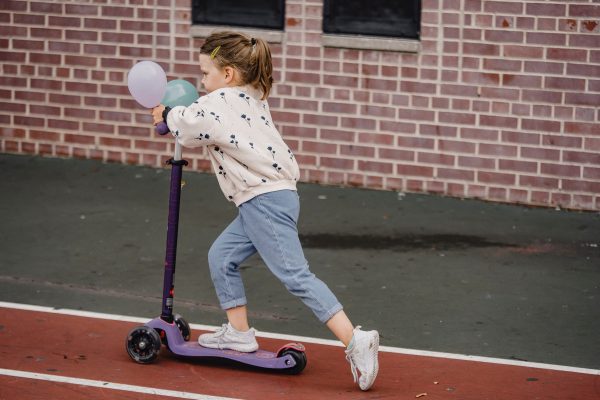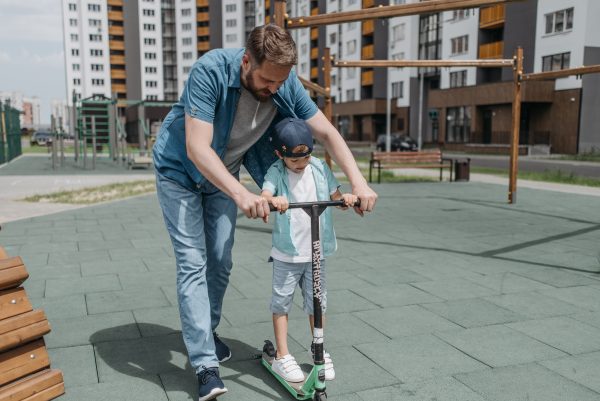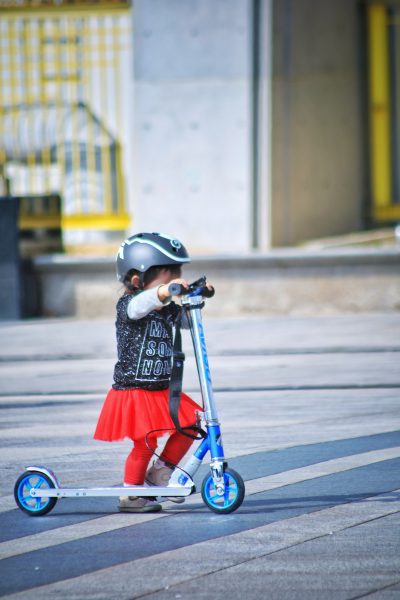Introducing your child to the world of play and exploration is a thrilling journey filled with choices that can significantly impact their early development. As they take their first steps towards independence, selecting the right gear becomes a paramount decision, one that combines safety, enjoyment, and growth. Among the myriad options available, a child’s scooter stands out as a delightful conduit to adventure, learning, and boundless fun. In this comprehensive guide, we delve into the art of choosing a scooter tailored to your little one’s needs and abilities. From striking the balance between safety and excitement to fostering their physical skills and boosting their confidence, we’ll navigate through the crucial checkpoints that transform a scooter into more than just a plaything. Join us as we uncover the key factors that make the selection process not only important but also an enriching experience for both children and their caregivers. So, let’s roll into the world of scooters and pave the way for unforgettable journeys of growth and discovery.

Key Takeaways
- Choosing a scooter for children is a significant decision with far-reaching impacts.
- Safety features, stability, and adjustability are crucial considerations for a child’s scooter.
- Prioritize two-wheelers that are age-appropriate and match your child’s skill level to reduce the risk of accidents.
- A well-designed scooter aids in developing balance, coordination, and motor skills, preparing children for future physical activities.
- The joy and excitement a suitable scooter brings to children enhance their outdoor adventures and confidence.
- Caregivers play a pivotal role in ensuring proper safety gear, supervision, and suitable riding environments.
- The selection process is a reminder of how seemingly simple choices contribute to a child’s growth and development.
- Choosing the right scooter isn’t just about a purchase; it’s about providing a gateway to exploration and learning for children.
Scooters For Toddlers
Scooters are quite common for children. Over the years, it has gained popularity as a fun and engaging outdoor activity for young children. They provide a great way for children to develop balance, coordination, and gross motor skills while enjoying the outdoors.
Many parks, playgrounds, and neighborhoods see children riding scooters alongside their parents or caregivers. The availability of a variety of its types, including those with three wheels for added stability, has contributed to their popularity among this age group. Additionally, scooters often feature colorful designs and characters that appeal to children, making them even more enticing.
Scooters are not only a source of entertainment but also contribute to healthy physical activity. Parents and caregivers appreciate that it encourage their children to be active and enjoy outdoor playtime. Furthermore, the transition from a scooter to a bicycle becomes smoother for kids who have gained balance and coordination through scootering.
However, while these are common and beneficial for toddlers, it’s essential to select a scooter that is appropriate for their age, skill level, and safety. Providing proper supervision, safety gear, and age-appropriate riding environments is crucial to ensuring a safe and enjoyable scootering experience for kids.

Different Types Of Scooters For Toddlers
There are several types of scooters designed specifically for children, each catering to different stages of development, skill levels, and preferences. Here are some common types for children:
- Three-Wheeled Scooters: These feature three wheels for enhanced stability, making them an excellent choice for children who are just starting to develop their balance and coordination. They usually have a wider deck and are easier to maneuver, making them suitable for younger kids.
- Two-Wheeled Scooters: As children grow and gain more confidence in their balance, they can transition to two-wheeled scooters. These vehicles help improve coordination and are a stepping stone to riding a regular two-wheeled bicycle.
- Convertible Scooters: Some scooters are designed to grow with your child. They can be converted from a three-wheeled to a two-wheeled configuration as your child’s skills progress. This type provides longevity and adapts to your child’s developmental stages.
- Kick Scooters: These are the most common type of scooters, where the child propels themselves forward by kicking off the ground. Kick scooters come in both three-wheeled and two-wheeled designs, offering options for different skill levels.
- Balance Bikes with Scooter Attachments: Some scooters are designed to be attached to a balance bike, essentially converting the bike into a scooter. This type of scooter encourages balance and coordination while giving children a unique riding experience.
- Character or Themed Scooters: Many scooters for kids feature popular characters, themes, or colors that appeal to young children. These scooters can make the riding experience more exciting and enjoyable for children.
- Lean-to-Steer Scooters: These scooters have a unique steering mechanism where the child leans in the direction they want to go. This type of scooter helps develop balance and coordination while offering a fun and engaging riding experience.
- Electric Scooters: Electric scooters for children are becoming more popular. These scooters are powered by a small electric motor and are usually designed for very young children. They move at slower speeds and often include safety features like limited speed settings and easy braking.
When choosing a scooter for your child, consider their age, developmental stage, and comfort level. It’s important to select a scooter that matches their current abilities while also allowing room for growth. Always prioritize safety features, stability, and quality construction to ensure a positive and safe riding experience for your little one.
Factors To Consider Before Buying Scooter For Your Toddler
Choosing a scooter for a kid requires careful consideration to ensure their safety, comfort, and enjoyment. Here are some important factors to consider:
- Age and Developmental Stage: Make sure the scooter is suitable for your kid’s age and developmental stage. Some scooters are designed specifically for younger kids, while others are better for older ones.
- Stability and Balance: Look for scooters with a wider base and stable design. Three-wheeled scooters often provide better stability for children who are still developing their balance and coordination.
- Height and Handlebars: Opt for a scooter with adjustable handlebar height. This allows you to customize the scooter as your kid grows, ensuring the right fit for their comfort and control.
- Weight Limit: Check the manufacturer’s weight recommendations to ensure the scooter can safely accommodate your kid’s weight.
- Safety Features: Look for scooters with features such as non-slip footboards, secure grips, and safety padding to minimize the risk of accidents and injuries.
- Materials and Construction: Select a scooter made from durable and lightweight materials. Sturdy construction ensures the scooter can withstand regular use and minor bumps.
- Wheels: Consider the type of wheels the scooter has. Larger wheels generally provide a smoother ride, especially if your child will be using the scooter outdoors.
- Braking System: Some child scooters come with a basic foot brake, while others might have more advanced braking systems. Select a scooter with a braking mechanism appropriate for your child’s ability to understand and use it.
- Ease of Use: Opt for a scooter that’s easy for your kid to control and maneuver. Intuitive steering and simple mechanisms will make the learning process smoother.
- Design and Themes: Select a scooter with a design or theme that your child will love. This can enhance their excitement about using the scooter.
- Reviews and Recommendations: Research reviews from other parents to get insights into the real-world performance and durability of the scooter you’re considering.
- Price: While price isn’t the only consideration, it’s important to find a scooter that offers good value for its features and quality.
- Safety Gear: Don’t forget to invest in appropriate safety gear, such as a well-fitting helmet, knee pads, and elbow pads. Safety should always be a top priority.
- Test Ride: If possible, allow your child to test ride the scooter before purchasing it. This can help you gauge their comfort and ease of use with the scooter.

source: pexels.com
Remember that every child is different, so select a scooter that suits your child’s individual needs and preferences. Prioritize safety, comfort, and quality when making your decision.
Conclusion
Choosing a scooter for your child is a decision that carries substantial significance. Beyond being a mere plaything, a child’s scooter serves as a gateway to a world of developmental milestones, confidence-building, and outdoor exploration. By carefully considering factors like safety features, stability, and adjustability, you set the foundation for a positive and enriching scootering experience.
Remember that safety remains paramount. Opting for a scooter designed with your child’s age and skill level in mind reduces the risk of accidents and encourages a smooth learning curve. Additionally, a scooter’s impact on your child’s physical development should not be underestimated. The right scooter fosters balance, coordination, and motor skills, preparing them for future physical activities.
Furthermore, the joy and excitement that a well-chosen scooter brings to a child’s face are immeasurable. Whether they’re cruising through the park, navigating the driveway, or joining playdates with newfound confidence, the scooter becomes a cherished companion in their early adventures.
As caregivers and parents, your role in this journey is pivotal. Ensuring proper safety gear, supervision, and age-appropriate environments all contribute to a secure and enjoyable scootering experience. The journey of selecting the perfect scooter is a reminder that even seemingly simple choices can play a profound role in your child’s growth and development.
So, as you embark on the path of choosing the ideal scooter, keep in mind the blend of safety, enjoyment, and learning that it offers. With careful consideration and thoughtful selection, you’re not just purchasing a scooter; you’re crafting a gateway to a world of exploration and discovery for your beloved kid.
At FamilyHype, we appreciate your feedback and invite you to share your experiences and opinions about choosing a scooter for a child.

